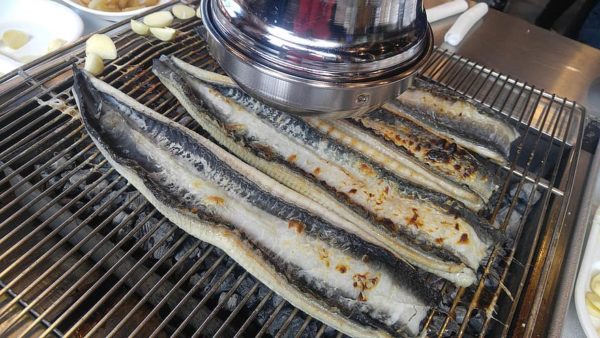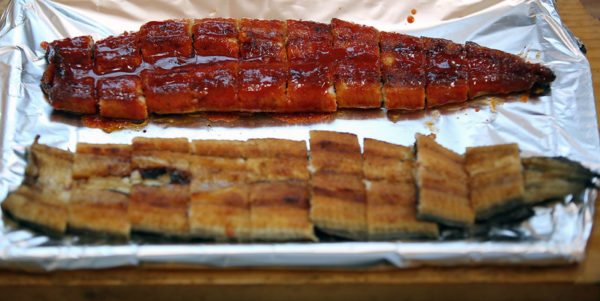There are two types of foods that Koreans always eat in summer. They are so ubiquitous where people will think you are a spy from a parallel world if you don’t think of them as classic summer dishes. Can you guess what they are? If you’ve been through the summer season in South Korea, you may know it. Or at least you may hear of it somewhere else because they are advertised everywhere during the summer.
Answers to this delicious question are Samgyetang, the chicken soup with ginseng, and Korean eel. While chicken is familiar to almost everyone in the world given that every country has a form of chicken noodle soup, eel can be a foreign dish. We will take you on a journey to dive into a strange food world. Let’s start it. This article is all about Korean style ell dishes.
Freshwater Eel
Eel is famous for health benefits especially restoring your energy level. This is why it’s considered a summer dish where people may be drained from the heat and humidity. In Korea’s neighboring country, Japan, people also enjoy eel dishes to boost their energy when temperature reaches the 90s. In South Korea, eel has long been believed as a remedy for low stamina. A common Korean saying states that eel can revive those who almost died from exhaustion! Needless to say, this is an exaggeration, Korean people have a special spot in their heart for delicious eel dishes. After all, believing in health remedies and benefiting from placebo effect can’t hurt anyone.
Eel can be broken into two categories: 1) freshwater eel and 2) sea eel. Typically, Koreans usually refer to the freshwater as eel as Seoul doesn’t have easy access to an ocean. For this reason, freshwater eel is typically preferred by Koreans. Freshwater eel is often used for grilled eel. Also, given that eel is mostly eaten during summer, the price of grilled eel definitely takes a hike between late June and late August.

Even though it is called a freshwater eel, it is different from freshwater fish that live its entire life in freshwater. Freshwater eel not only lives in freshwater, but also spends its life time in the ocean. It is the opposite of salmon spawning in rivers and growing in the sea. Fresh eel spawns in the sea and grows while living in the river.
Most of the freshwater eel that Koreans normally eat is a farmed eel, not wild caught. When it reaches the mouth of the river after hatching in the sea, it is still too small to eat. So farmers would release young eels into the wild to grow. It takes about 7 months to reach full maturity and then used as an ingredient. People usually eat freshwater eel by roasting with seasonings.
Its flesh has a more chewy texture than sea eel. And its skin is a bit tough, but has an interesting taste. When grilled with salt or seasoning, it shapes itself like a seagull as it rolls outside in the direction of its skin. Some restaurants use eel’s backbone as a tempura. Fried backbone of eel is well known as a delicacy in South Korea.
Sea Eel, Known as ‘Anago’ in Japanese
Among the various sea eel species, conger eel is the most famous. It is also referred to as the Japanese name “Anago”. Some Koreans group the sea eel with freshwater eel in the same category, but they are totally different from each other. The conger eel has a brown back, a white belly. And a clear white dot is lined up like a dotted line on the side of the body, so making it easy to distinguish it from freshwater eel.

Conger eel inhabit all coastal waters of Korea and are mostly wild, not farmed. Unlike freshwater eel, which is not usually eaten in the form of raw fish, you can enjoy conger eel as a sushi. However, it has much larger bones embedded in its flesh. Therefore, you must chop the eel into small pieces before eating as a raw fish. If not, a fish bone lodged in your throat. In addition, eel blood has a toxic substance, and eating uncooked blood may lead to diarrhea, nausea, and difficulty in breathing. To prevent these kinds of dangerous situations from happening, we recommend that you visit a restaurant instead of buying them fresh at fish markets like Noryangjin fish market.
Typical Stamina Health Food
Koreans treat eel as a “symbol of power”. Because of its high protein and vitamin A content, it has long been highly regarded as a stamina food. The essential fatty acid contained in eel acts as a good fat when it enters the human body by not hardening itself in the blood vessel. It also melts hard fats in the blood vessels to keep the vein in clean condition. By doing this, nutrients and oxygen-rich blood in veins can be supplied to activate each organ functions.
Unsaturated fatty acids in eel are the main components of cell membranes. It forms a cell membrane of the immune system along with the cells that make up the human body. So it is good for growing children or elderly people with low immunity. Additionally, it can be a good nutritional supplement for pregnant women and fetuses, too. As many of the brain’s constituents consist of lipids, it helps develop the brain of the fetus.
When you visit a restaurant specializing in eel, you can choose how to cook eel. They offer 3 choices as follows: red pepper paste, soy sauce, and salt grill with salt. Of these, eating salted grilled eel with vegetables is the best way to absorb nutrients more evenly into our body. The restaurant may offer sliced gingers. By eating together with eel dishes, it helps promote your digestion and boost detoxing enzymes in the liver.